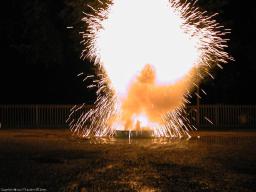|
|
|
|
|
|
|
|
|
|
I have a special fondness for sodium. Directly or indirectly, you're probably reading this because of my sodium party, which was largely responsible for the popularity of my web site. The party was based on the ability of sodium to separate hydrogen from water, an ability shared by all the elements in the alkali metals group (the left-most column of the periodic table).
If you drop sodium into water, it tears the water apart, releasing hydrogen gas into the air. The hydrogen usually explodes not long after, ignited by the heat released by the sodium during the reaction. Go visit the sodium party and you'll see what I mean.
As with any reactive element, sodium's character is changed completely when it's incorporated into a chemical compound. Let sodium, a reactive metal, and chlorine, a poisonous, choking gas, react with each other (which they do with a violent explosion) and the result is common table salt, NaCl, blowing out all over the place. Isn't the world a wonderful place to live?
|
|
| |
|
|
|
|
|
Lump, 99.95%.
Kindly donated by David Franco, who sent many elements after seeing the slashdot discussion, and this one after I sent him some Mathematica t-shirts.
Source: David Franco
Contributor: David Franco
Acquired: 11 June, 2002
Price: Donated
Size: 0.5"
Purity: 99.95%
|
|
|
|
|
|
|
   Heck-of-a-lump. Heck-of-a-lump.
This is an alarming three and a half pounds of sodium metal in a glass desiccator. The sodium is from eBay and the desiccator is from the Bridgestone/Firestone plant closing auction (the one caused by those faulty tires in 2001). I've briefly removed the lid to take this picture, and used a chisel to make a fresh cut into the metal (which is extremely soft). The cut is at the top right of the picture: It would normally be shiny, but it is so humid here in the summer that it oxidized to white even though I took this picture within five seconds of making the cut. Hence the need for a desiccator (with silica gel desiccant) to store it for any length of time, and even then I'm careful to leave the stopper in loose to relieve gas pressure that could build up from any moisture that remains.
The sound and video for this sample were made during my Sodium Party in the fall of 2002. During this event we dropped about 2 pounds of it, in chunks ranging from 50 grams to 175 grams, into various containers of water. It looked something like this:

Click the story book icon for this sample to read all about the party, and see videos of the many and varied ways in which sodium can explode.
This sodium is too dangerous to keep in the office with the table, and I wouldn't even want to have this much of it around in my shop: If it were to, for example, fall and break on a day when the shop floor has flooded,which happens from time to time, it could easily cause an explosion that would shatter the shop windows. That's another reason for throwing most of this enormous sample into water sometime soon: It's about the only way to make it safe.
Source: eBay seller hoofcure
Contributor: Theodore Gray
Acquired: 27 August, 2002
Price: $100
Size: 8"
Purity: >95%
|
|
|
|
|
|
|
|
|
|
Sample from the Everest Element Set.
Up until the early 1990's a company in Russia sold a periodic table collection with element samples. At some point their American distributor sold off the remaining stock to a man who is now selling them on eBay. The samples (excepted gasses) weight about 0.25 grams each, and the whole set comes in a very nice wooden box with a printed periodic table in the lid.
To learn more about the set you can visit my page about element collecting for a general description and information about how to buy one, or you can see photographs of all the samples from the set displayed on my website in a periodic table layout or with bigger pictures in numerical order.
Source: Rob Accurso
Contributor: Rob Accurso
Acquired: 7 February, 2003
Price: Donated
Size: 0.2"
Purity: >99%
|
|
|
|
|
|
|
|
|
|
|
|
|
|
|
|
|
|